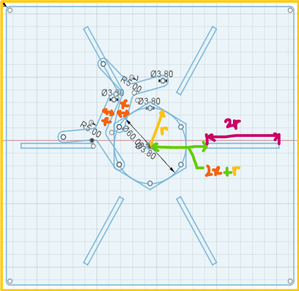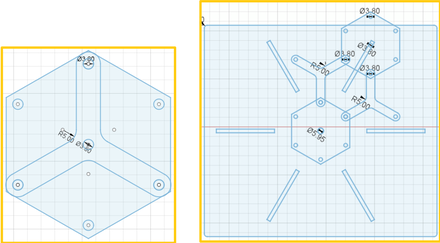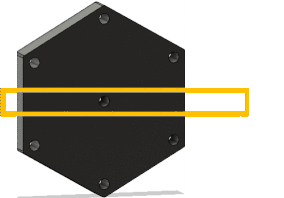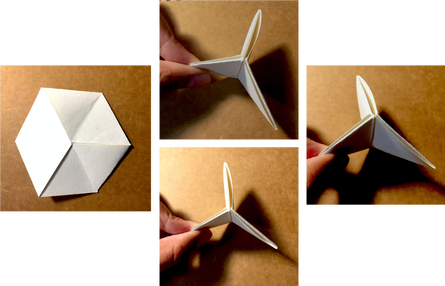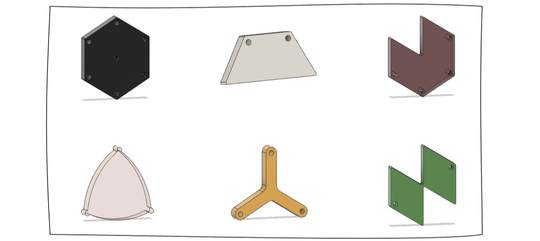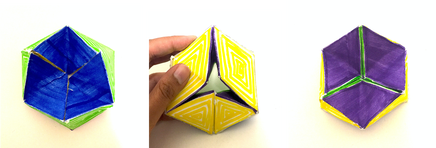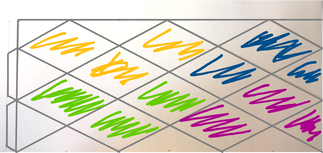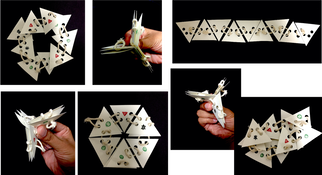HEX-FLEX
Hands-on explorations with hexagons, their properties and mechanical movements
THE CONCEPT
In an attempt to find mathematical connections in making and fabricating, I accidentally happened to explore interesting properties of hexagons creating some fun mechanical movements. This design was inspired by the Hoberman sphere - an isokinetic sculpture that resembles a geodesic dome but is capable of folding down to a fraction of its normal size.
In an attempt to find mathematical connections in making and fabricating, I accidentally happened to explore interesting properties of hexagons creating some fun mechanical movements. This design was inspired by the Hoberman sphere - an isokinetic sculpture that resembles a geodesic dome but is capable of folding down to a fraction of its normal size.
MATHEMATICAL CONNECTIONS
This kinetic sculpture draws fascinating connection with math as a part of it making and designing process. It's almost unbelievable how easily one could prototype something complex with easy math.
|
|
UNDERSTANDING THE MOTION
The knob on the central hexagon offers a 180 degree rotation instead of the full 360 degree turn.
This is because while designing this sculpture, the length of he slot in the base was '2r'. Since there is a hexagon translating within the slot, which also has a circle of radius 'r' inscribed within itself and the rotation of the central hexagon (with another inscribed circle with radius 'r'); thus making the rotation restricted within the slot and only upto a 180 degrees.
NEXT STEPS
The next steps for this project are to use this sculpture as a tool for open-ended knowledge construction targeting audiences of all age groups.
I imagine the kinetic sculpture to be a part of a public installation. With the sculpture in motion in front of the visitors eyes, there would be spaces for open-ended explorations using the pieces of the sculpture.
In an attempt to do that, I'm looking at origami-based designs of a 'Flexagon'.
In geometry, flexagons are flat models, usually constructed by folding strips of paper, that can be flexed or folded in certain ways to reveal faces besides the two that were originally on the back and front.
I'm looking at two-dimensional making spaces with flat flexagons and three dimensional making spaces with 3D hexa-flexagons as building units.
The next steps for this project are to use this sculpture as a tool for open-ended knowledge construction targeting audiences of all age groups.
I imagine the kinetic sculpture to be a part of a public installation. With the sculpture in motion in front of the visitors eyes, there would be spaces for open-ended explorations using the pieces of the sculpture.
In an attempt to do that, I'm looking at origami-based designs of a 'Flexagon'.
In geometry, flexagons are flat models, usually constructed by folding strips of paper, that can be flexed or folded in certain ways to reveal faces besides the two that were originally on the back and front.
I'm looking at two-dimensional making spaces with flat flexagons and three dimensional making spaces with 3D hexa-flexagons as building units.
EXPLORATIONS IN THE 2D SPACE
This space also envisions on consisting of puzzle pieces which would be serve as geometric pieces in building.
This ensures a wide range of age groups to engage with the tangible pieces of the sculpture.
.
EXPLORATIONS IN THE 3D SPACE
In the 3D space, a three-dimensional flexagon as a building unit of a larger open-ended sculpture can be constructed. This is a zone running completely on freely flowing creativity. Here are some building unit prototypes.
EXPLORATIONS IN THE 3D SPACE
In the 3D space, a three-dimensional flexagon as a building unit of a larger open-ended sculpture can be constructed. This is a zone running completely on freely flowing creativity. Here are some building unit prototypes.


